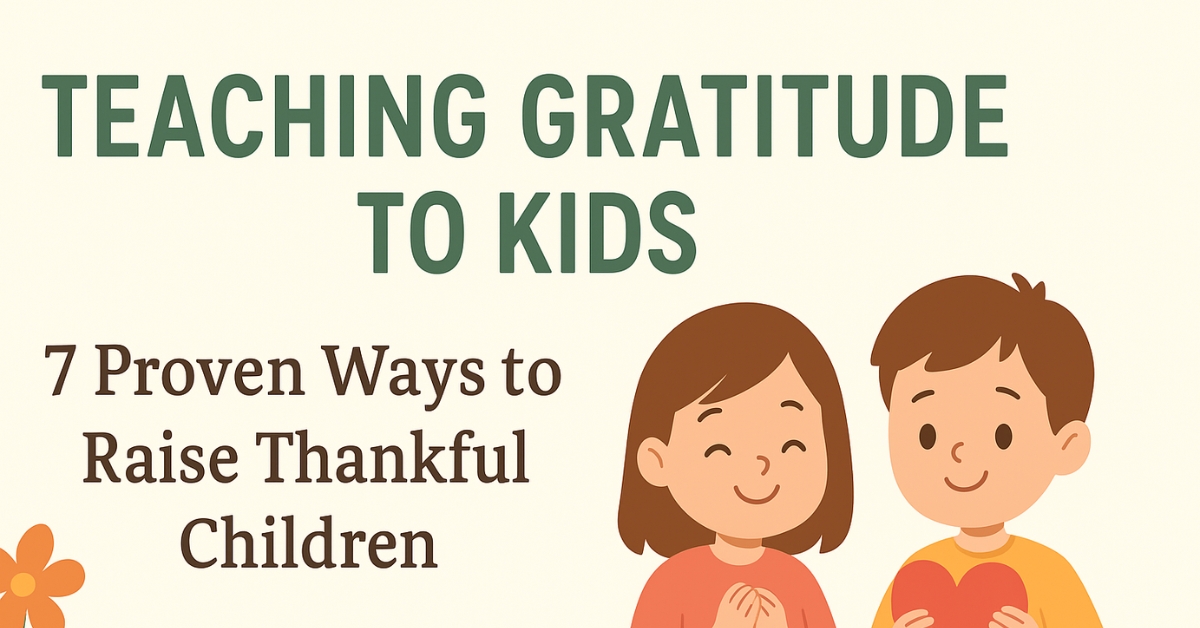7 Proven Ways to Raise Thankful Children
Gratitude is a universal language. No matter where you live or what language you speak, saying “thank you” expresses appreciation and respect. But here’s the real challenge—how do we move beyond just words and actually help our children feel grateful?
In today’s world, kids are often surrounded by abundance—gifts, gadgets, and opportunities. Yet without intentional teaching, they might overlook the value of what they have. As parents, it’s our role to guide them toward a grateful mindset. This article will share practical and heartwarming ways for teaching gratitude to kids so they not only say thank you but also truly mean it.
Why Gratitude Matters for Kids
Research shows that children who practice gratitude are:
- Happier and more optimistic
- Less likely to feel depressed or anxious
- More empathetic and kind toward others
- Better at handling challenges and setbacks
Gratitude is the secret ingredient to happiness. It’s hard to be grateful and unhappy at the same time. By nurturing gratitude, you give your kids one of the most valuable life skills.
1. Be a Role Model: Show Your Own Gratitude
Children learn more from what we do than what we say. If you want to raise grateful kids, start by practicing gratitude yourself.
- Say thank you to your partner, family, or even the cashier at the store.
- Share small moments of appreciation like, “I’m so thankful for this meal” or “I really appreciate your help today.”
- Let your child see you expressing gratitude genuinely, not just out of politeness.
👉 Remember: Kids mirror our behavior. If you want them to be thankful, they must first see you living it.
2. Teach the Real Value of “Thank You”
Simply saying thank you is important, but kids should also understand why they are saying it.
- When someone gives your child a gift, explain:
“Your aunt gave you this because she cares about you. Saying thank you is how we show her that we appreciate her love.”
- Encourage thank-you notes, drawings, or even small gestures to express gratitude.
- Make gratitude about feelings, not just words.
3. Involve Kids in Household Responsibilities
Helping at home builds a sense of belonging and responsibility. Gratitude grows when kids understand they are part of something bigger—the family.
- Assign age-appropriate chores (without payment).
- Appreciate their efforts by saying, “I’m thankful you helped set the table today.”
- This reinforces that their contribution matters.
4. Let Them Participate in Purchases
When kids get everything handed to them, they may struggle to value it. Instead, let them:
- Save money for a toy or contribute to a purchase.
- Take part in decisions about family expenses (like choosing between two fun activities).
- Earn small rewards through effort and responsibility.
👉 This helps them understand effort, sacrifice, and true appreciation.
5. Encourage Helping Others
Gratitude often deepens when kids realize how fortunate they are compared to others.
- Volunteer together at community events.
- Donate toys, clothes, or food to those in need.
- Encourage kindness at school by helping a new student, sharing with classmates, or comforting a friend.
Helping others teaches kids to be less self-centered and more thankful.
6. Expose Them to Different Environments
Travel—or even short local visits—can open kids’ eyes.
- Take them to areas where people have fewer resources.
- Visit cultural or historical places to see how others live.
- Discuss what makes their life comfortable and why they should appreciate it.
This gives them perspective and helps them value their blessings.
7. Start a Gratitude Journal
Writing down gratitude makes it more powerful.
- For younger kids: ask them at dinner, “What are you grateful for today?”
- For older kids, encourage them to keep a gratitude journal where they write down three things they’re thankful for each day.
- Over time, this becomes a positive habit that strengthens their mindset.
Frequently Asked Questions
Q1: At what age should I start teaching gratitude to kids?
You can start as early as 2–3 years old. At this age, children can understand simple thank-yous. As they grow, you can introduce deeper lessons through activities, journaling, and helping others.
Q2: What are some fun activities to teach gratitude to kids?
Activities like gratitude journaling, writing thank-you notes, volunteering together, family gratitude games, and sharing “what made you happy today” at dinner are effective and fun.
Q3: How can I encourage my child to be more thankful?
The best way is to model gratitude yourself. Say thank you often, appreciate small things, and highlight blessings in daily life. Children learn best by watching their parents.
Q4: Why is teaching gratitude to kids important?
Gratitude helps kids become happier, less anxious, more empathetic, and resilient. It teaches them to value relationships, appreciate what they have, and develop a positive outlook on life.
Q5: Can gratitude reduce negative behavior in children?
Yes. Kids who practice gratitude are less likely to be self-centered or demanding. Instead, they learn kindness, patience, and empathy, which improve behavior and family harmony.
Final Thoughts: Gratitude is a Journey, Not a Lesson
Teaching gratitude to kids doesn’t happen overnight. It’s a daily practice built through small habits, role modeling, and consistent encouragement.
The more you talk about gratitude, practice it, and highlight little blessings, the more your children will naturally develop an attitude of thankfulness.
So, tonight, ask your child:
👉 “What’s one thing you’re grateful for today?”
You may be surprised by the simple but heartwarming answers.




